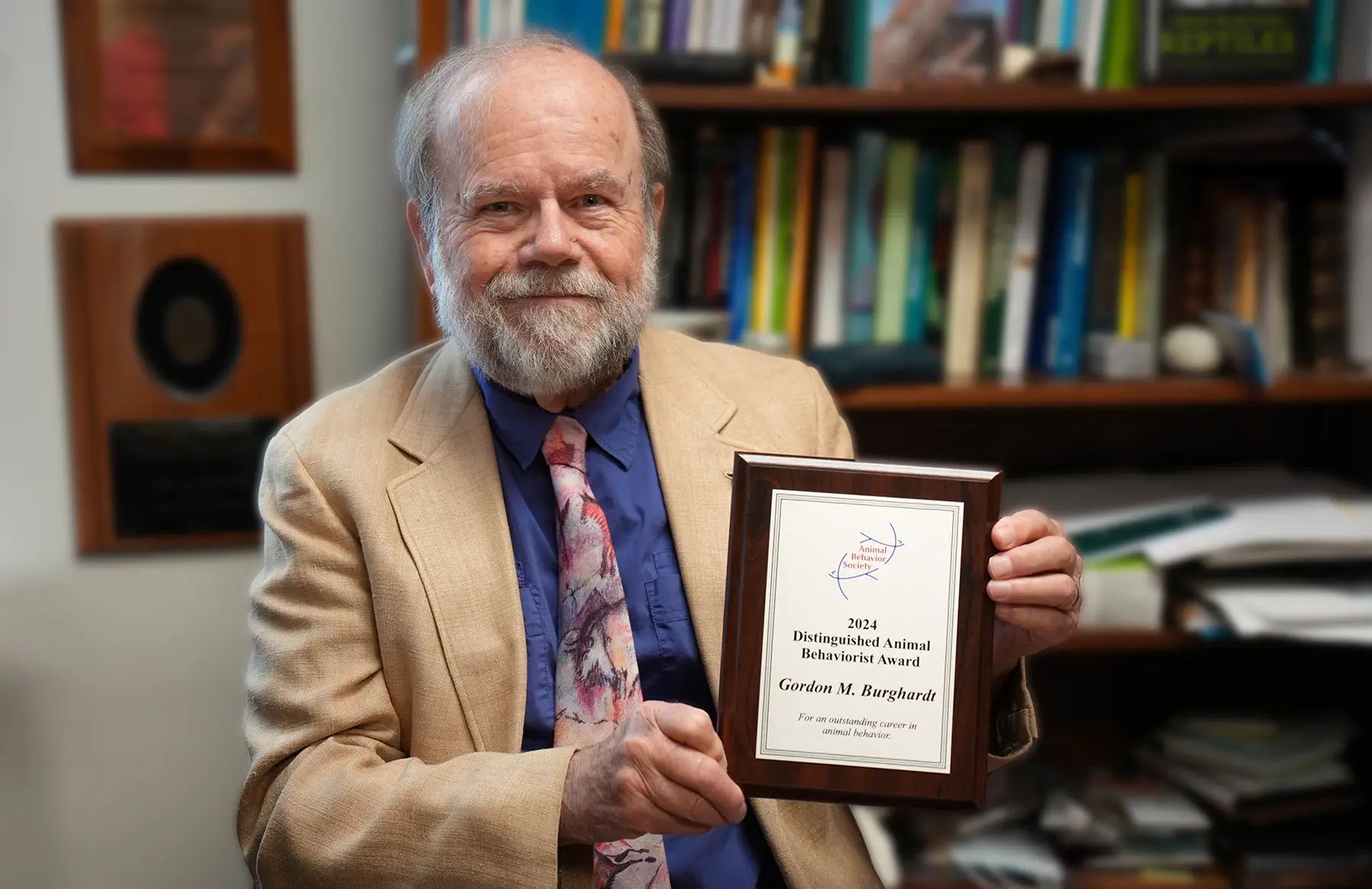Burghardt honored by Animal Behavior Society

Animal behavior captivated Gordon Burghardt as a boy, and over more than half a century at the University of Tennessee, Knoxville, his interdisciplinary research advanced ethology in areas including animal play, social behavior, communication, reptile behavior, enrichment, and animal cognitive abilities.
The Animal Behavior Society (ABS) recognized his outstanding lifetime achievement by awarding Burghardt the 2024 Distinguished Animal Behaviorist Award during its annual meeting in late June.
Interest to Interdisciplinary Investigation
During his childhood in Wisconsin, Burghardt collected snakes. He also developed an interest in chemistry, and that was his major when he entered the University of Chicago in 1959. Despite his curiosity about animals, Burghardt said, “I was always told you couldn’t make a career, support a family, studying biology at that time.”
A class on animal behavior with Eckhard Hess led Burghardt to major in biopsychology, earning his PhD in 1966. He was drawn to UT by the head of the Department of Psychology and Neuroscience, William S. Verplanck, who had worked with B.F. Skinner and other leading psychologists.
“The faculty were bright and young and growing, and they had a lot of people in experimental psychology working with animals,” Burghardt said. “I came, and I’ve been able to develop my own programs and courses, and had many grad students doing research.”
He founded a UT interdisciplinary Life Sciences Graduate Program in Ethology in 1981, one of several designed to break down departmental silos.
Although Burghardt started as an assistant professor in the Department of Psychology in 1968, he was always involved with the Department of Zoology and its graduate students. He noted the interdepartmental cooperation and collegial, supportive relationships within and between departments. “That’s developed even more now,” he said, pointing to the number of joint appointments. “I was the first one,” he said, also becoming a professor in the Department of Zoology in 1995 (now the Department of Ecology and Evolutionary Biology, or EEB).
Burghardt has worked with chemists, too, to research snakes’ chemical senses. He became one of the first editorial board members of The Journal of Chemical Ecology, one of numerous publications on which he has worked. He has served in leadership positions with multiple professional organizations too, including ABS and the American Psychological Association.
Burghardt’s excitement is evident when he talks about the first time he observed neonate snakes responding to prey chemicals, and he’s still publishing research on snake chemoreception.
Studying Play
Shortly after Burghardt arrived at UT, the university forged a relationship with the Great Smoky Mountains National Park for research on black bears, which were experiencing troubling encounters with tourists.
In 1970, two cubs found in the Smokies without their mother spent about seven weeks at Burghardt’s Knoxville home, until an area was ready for them in the park. The experience gave him an unusual observation opportunity.
“They were super playful,” Burghardt said. “They were the most playful animals that I’ve ever seen.”
That opened a new area for research, and Burghardt not only developed a definition of play but with his colleagues was the first to definitively document play in fish, turtles, and other species.
In 2005, his book The Genesis of Animal Play: Testing the Limits (MIT Press) examined the origins and evolution of play, reviewing evidence from species ranging from human babies to lizards, sharks, octopus, and insects. He has contributed to several other books on the topic, and his research also is extensively cited in the 2024 book Kingdom of Play: What Ball-bouncing Octopuses, Belly-flopping Monkeys, and Mud-sliding Elephants Reveal about Life Itself, by David Toomey.
Serpents, Iguanas, and Other Reptiles
Burghardt’s fascination with snakes led to numerous studies, with subjects ranging from neonates to a two-headed rat snake named IM that lived for decades in his lab.
He also taught a course on the psychology of religion, when it was a joint course with the Department of Religious Studies. “Snakes are the most important animal in religions,” he said, pointing around his office in the Austin Peay Memorial Building to artifacts and books from several faiths.
A trip to Panama to look at snakes led to his research on social behavior of newly hatched iguanas, uncovering social complexity unheard of in reptiles. Burghardt was unable to attend the ABS ceremony in Ontario to receive his award because it conflicted with his attending a centennial symposium at Barro Colorado Island, part of the Smithsonian Tropical Research Institute, where he and his students observed the iguanas.
He and then-student Brian Bock served as scientific advisors on a British Broadcasting Corp. episode of Wildlife on One, “Iguanas, Living Like Dinosaurs,” narrated by David Attenborough.
Burghardt and his colleagues also studied a Komodo dragon named Kraken at the Smithsonian’s National Zoo and later a Komodo dragon at Zoo Knoxville, also featured in two documentary films on play.
He is co-author of the 2021 book The Secret Social Lives of Reptiles and editor on the second edition of Health and Welfare of Captive Reptiles.
“It was really important that the university supported and appreciated the kind of stuff that I was doing, even though it was not at all traditional in terms of what psychologists typically do,” he said. “My work, I think, has been pretty well recognized, as this award shows, so I was on to something.”
While Burghardt still serves on a couple committees of graduate students completing their dissertations, he notes that some of his former students are retiring.
“I just retired two years ago, but they’re not hanging on until 80, like I did,” he said. “Doing my research, what I wanted to do, keeps you younger.”
“I really love the field of animal behavior and feel that I’m still able to make substantial contributions,” said Burghardt, who in addition to publishing his own research is founding editor of a new journal, Frontiers in Ethology.
By Amy Beth Miller